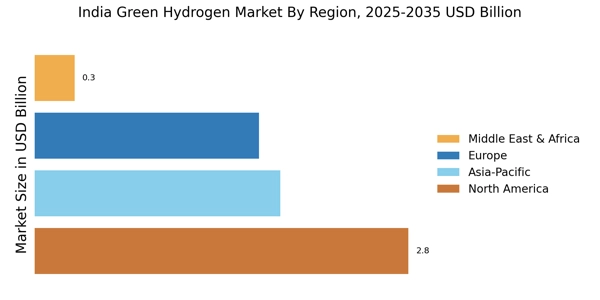Government Support and Policy Framework
The India Green Hydrogen Market is currently experiencing a robust push from government initiatives aimed at promoting renewable energy sources. The Indian government has set ambitious targets, including the National Hydrogen Mission, which aims to produce 5 million tonnes of green hydrogen annually by 2030. This policy framework not only provides financial incentives but also establishes a regulatory environment conducive to investment in green hydrogen technologies. The government's commitment to reducing carbon emissions and enhancing energy security further solidifies the market's potential. With a projected investment of over USD 8 billion in green hydrogen projects, the India Green Hydrogen Market is poised for substantial growth, attracting both domestic and international players.
Technological Innovations in Electrolysis
Technological advancements in electrolysis are pivotal for the India Green Hydrogen Market. Innovations in proton exchange membrane (PEM) and alkaline electrolysis technologies are enhancing efficiency and reducing costs. As of 2025, the cost of producing green hydrogen through electrolysis is expected to decrease significantly, potentially reaching USD 1.5 per kilogram. This reduction in production costs is likely to make green hydrogen more competitive with fossil fuels, thereby increasing its adoption across various sectors, including transportation and industrial applications. The ongoing research and development efforts in this domain suggest that the India Green Hydrogen Market will benefit from improved technologies that facilitate large-scale production and distribution.
Investment Opportunities and Economic Growth
The India Green Hydrogen Market is witnessing a surge in investment opportunities, driven by both public and private sector interest. With the government targeting a USD 8 billion investment in green hydrogen projects, numerous companies are exploring partnerships and collaborations to capitalize on this emerging market. The potential for job creation in manufacturing, research, and infrastructure development is substantial, with estimates suggesting that the green hydrogen sector could create over 1 million jobs by 2030. This influx of capital and talent is likely to stimulate economic growth and innovation within the India Green Hydrogen Market, positioning it as a key player in the global energy landscape.
International Collaboration and Trade Potential
The India Green Hydrogen Market is increasingly benefiting from international collaboration and trade opportunities. Countries with advanced hydrogen technologies are looking to partner with India to leverage its vast renewable energy resources. Collaborative projects, such as joint ventures and technology transfers, are emerging, which could enhance India's capabilities in green hydrogen production. Furthermore, as nations strive to meet their climate commitments, the demand for green hydrogen is expected to rise, creating export opportunities for India. The potential for India to become a leading exporter of green hydrogen in the coming years could significantly impact the India Green Hydrogen Market, fostering economic ties and enhancing energy security.
Rising Energy Demand and Transition to Renewables
The India Green Hydrogen Market is being driven by the increasing energy demand coupled with a global transition towards renewable energy sources. As India aims to achieve 500 GW of renewable energy capacity by 2030, the role of green hydrogen as an energy carrier becomes increasingly vital. The International Energy Agency projects that hydrogen could account for 18% of the global energy demand by 2050, indicating a substantial market opportunity for India. This transition not only aligns with India's climate goals but also offers a pathway to energy independence. The growing recognition of green hydrogen's potential in decarbonizing hard-to-abate sectors further enhances its relevance in the India Green Hydrogen Market.


















Leave a Comment